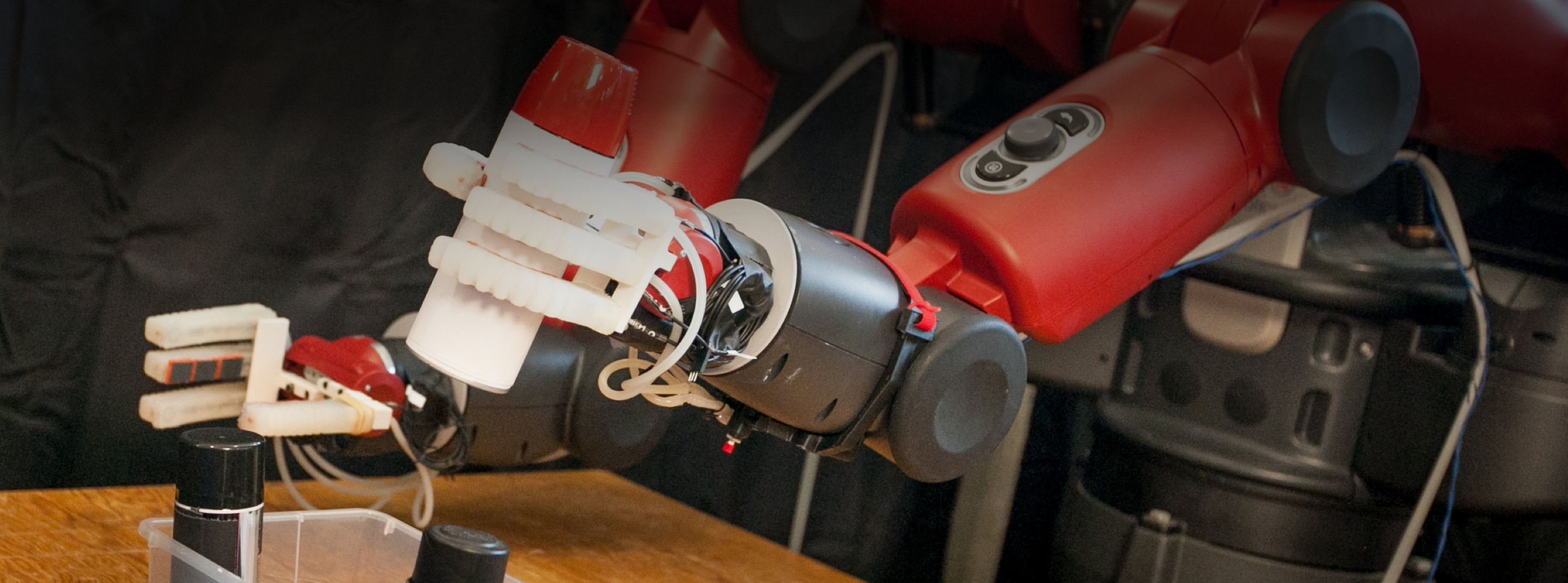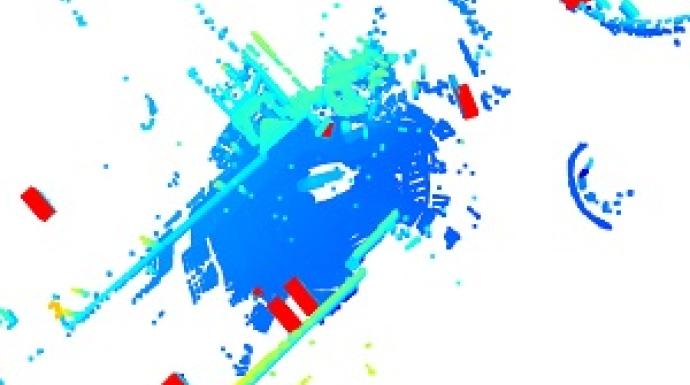Audrey Woods, MIT CSAIL Alliances | October, 14, 2025
Geometry is everywhere. It underpins the graphics in movies and video games, is critical to manufacturing and design, and helps us make sense of medical imagery. Growing industries like robotics and autonomous cars are tackling key geometry questions, made more difficult by noisy and incomplete data. And many don’t realize how deeply geometry can help understand and create computational architectures for big data, machine learning, and artificial intelligence—in three dimensions and beyond.
MIT CSAIL Associate Professor and leader of the Geometric Data Processing (GDP) Group Justin Solomon finds the diversity of problems he studies “ridiculously fun.” Working across industries on challenges that change by the day, he’s excited not only to be exploring what’s possible with geometry but also educating the next generation on this widely-applicable but little-known subfield of computer science. Between his group’s research and his Summer Geometry Initiative, Professor Solomon is making applied geometry accessible, collaborative, and engaging.
GEOMETRIC DATA PROCESSING: A UNIQUE RESEARCH AREA
Professor Solomon was lucky to be exposed to computer science at a young age. In high school, he built a ray tracer for 3D rendering and later spent a summer at the Naval Research Laboratory in Washington, DC coding an algorithm for computing curvature on a triangle mesh, an experience he describes as “oddly close to what my research group does now.” In college, he spent time at Pixar Animation Studios doing physical simulation and 3D graphics, where he was credited in the movie Up. After finishing his PhD in computer science at Stanford and a Postdoctoral Fellowship in math at Princeton, he came to MIT CSAIL.
He admits that what his GDP group does is “a little hard to pin down.” Fundamentally, their work revolves around applied geometry in two domains: low-dimensional geometry and high-dimensional geometry. Low-dimensional geometry is what most people might imagine when it comes to geometry research, including 3D modeling, animation, and medical imaging. For example, his student Leticia Mattos Da Silva recently shared a new technique for simulating the motion of squishy objects like gummy bears, which would enable animators to create realistic bouncy, elastic, rubbery, or stretchy objects or characters while staying true to real-world physical laws. His student Ana Dodik, along with several other collaborators at MIT, also has a project for 3D modeling of M.C. Escher-style “impossible” objects, offering animation and graphics opportunities in the digital domain that aren’t constrained by physical reality.
One problem Professor Solomon has worked on for a long time is creating machine learning (ML) models to understand 3D data, a common challenge in autonomous driving and 3D sensing. “Developing algorithms for understanding the environment around the car to find pedestrians, other cars, and so on is a key example of the sorts of machine learning problems that we’re tackling.”
Furthermore, there’s an inherent problem with 3D data in that there isn’t that much of it available. There’s a whole internet full of labeled 2D data, but it’s much more difficult to gather the volume of annotated data needed for traditional ML methods, like supervised learning. Professor Solomon and his students have been exploring self-supervised algorithms that leverage unlabeled data with just a little bit of annotation, as well as algorithms that indirectly learn about 3D problems from other types of data. Another of his students, Artem Lukoianov, crafted a method for generating 3D images using traditional 2D image diffusion models without the need for retraining or fine-tuning, opening avenues in 3D imagery with currently available technology.
On the high-dimensional side, Professor Solomon’s group explores how geometry can help understand large datasets and offer better techniques for ML and natural language processing. Consider a dataset like a survey, where a million people answer twenty questions. Although this data is 20-dimensional, geometric algorithms might attempt to understand such a dataset as a lower-dimensional objects embedded in 20-dimensional space. “Many abstract algorithms for thinking about how data cuts through this high-dimensional space are geometric in nature.” As a simple example, scientists might talk about data points being close together or far apart, which are inherently geometric terms. “So the same theory that we use to think about low dimensional, 3D-style modeling problems can lead to interesting and powerful algorithms for high-dimensional inference and statistics.”
High-dimensional geometry might also be useful for navigating specialized instances of larger, universal models. Professor Solomon explains how, in the beginning, AI models were very specific and crafted to address a particular problem. “These days, the top performing models are generalists,” but now companies want ChatGPT-style models fine-tuned on proprietary data or specific information, which has “led to an ecosystem of millions of small adjustments being made to one big model that are all slightly different from one another.” Through a longstanding relationship with the MIT-IBM Watson AI Lab, Professor Solomon and his team have been studying how to have it both ways, compressing those fine-tuned models so they can be swapped in and out, allowing users to navigate between the generalist model and various fine-tuned specialist models. “ That might not sound like a geometry problem, but the way that we're modeling it behind the scenes mathematically definitely is.”
THE SUMMER GEOMETRY INITIATIVE
Another endeavour Professor Solomon is passionate about is his annual Summer Geometry Initiative (SGI), a multi-university effort to introduce more students to applied and computational geometry. “Geometry is not typically included in undergrad curricula, which means our PhD students often come from a relatively small pool of places where you get exposed to the field. A lot of people don’t even know it exists or only know it at a high level.”
To bring a broader audience to geometry research, Professor Solomon started the SGI in 2021. It includes six weeks of training, hands-on projects, and expert mentorship from a pool of engaged professors at several institutions. This gives participants a wide array of experiences across multiple areas over a short period of time. “The outcomes have been really successful. We’ve had five cohorts of students at this point, and many have gone on to PhDs in the field. We’re just starting to see them graduate. Others have gone into industry. It’s clear from the statistics that this wouldn’t have happened without our intervention.”
Because SGI aims to replicate the experience of an internship, it is fully-paid. This guarantees total focus, where students don’t have to split their attention, but also makes the program expensive to run. Professor Solomon says sponsors are always welcome and is grateful to CSAIL Alliances for supporting SGI.
FUTURE WORK & AN INVITATION TO COLLABORATE
Over the course of Professor Solomon’s career, he’s seen geometry software become extremely sophisticated, but there is still work to be done in integrating the latest ideas and tools from the research community. 3D printing and computer graphics have been slow to adopt such methods, a gap Professor Solomon’s group is actively trying to bridge. Generally, Professor Solomon wants geometry-based tools to be accessible to a broader audience, offering 3D modeling and printing capabilities to everyday computer users the way we now have word processors and photo editors. ”What would be really amazing is for a wider base of users to be able to create 3D content in their homes, without being experts on all the details of modeling, meshing, and differential equations. We’re working on that.”
Professor Solomon emphasizes the generalist, collaborative, and porous nature of their group, encouraging interested companies to reach out. “We have industry friends who come in and out of the lab all the time, bringing interesting challenges. We’re here to help them understand the essence of their problems from a geometric perspective.” The group welcomes visiting industry researchers because it gives them insight into industry problems while offering training and perspective for companies. Professor Solomon has also been involved in CSAIL Alliances Research Initiatives like FinTech@CSAIL and Machine Learning Applications (MLA@CSAIL), and he is excited about the upcoming Visual Computing theme under MLA@CSAIL.
“CSAIL Alliances has been one of the most valuable members of the MIT community for this research group,” he says. “For those in industry who are interested in collaborating, contact me to schedule a time to chat. It's our pleasure to learn more about unexpected applications of geometry research motivated by real-world problems. But we can only do that with your help.”




